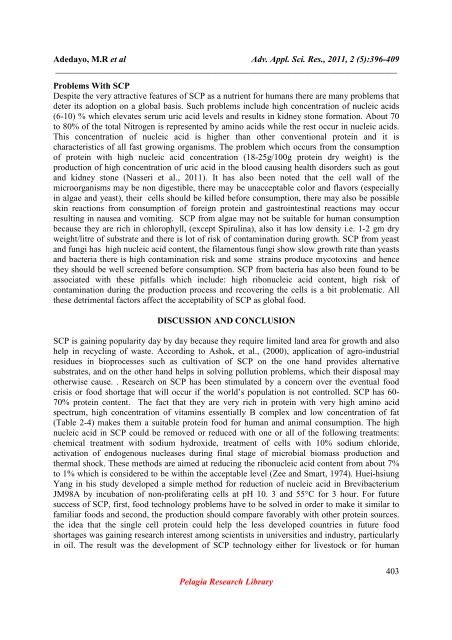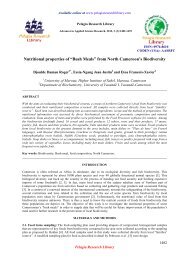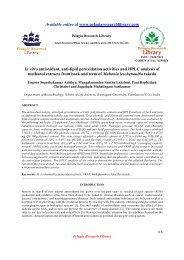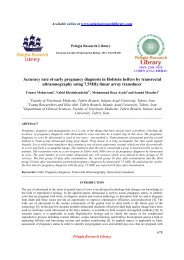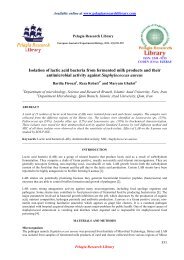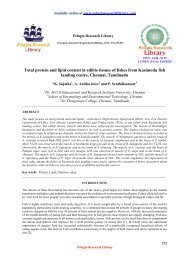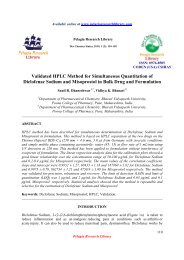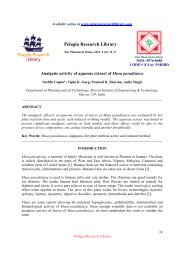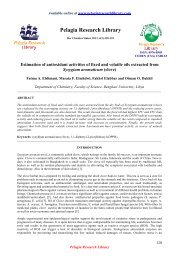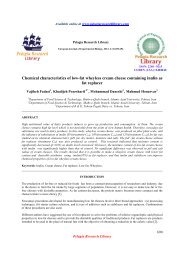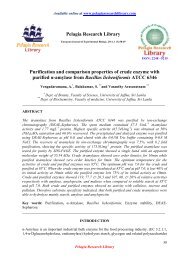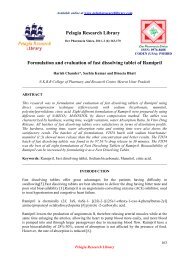Single Cell Proteins: As Nutritional Enhancer. - Pelagia Research ...
Single Cell Proteins: As Nutritional Enhancer. - Pelagia Research ...
Single Cell Proteins: As Nutritional Enhancer. - Pelagia Research ...
You also want an ePaper? Increase the reach of your titles
YUMPU automatically turns print PDFs into web optimized ePapers that Google loves.
Adedayo, M.R et al Adv. Appl. Sci. Res., 2011, 2 (5):396-409<br />
_____________________________________________________________________________<br />
Problems With SCP<br />
Despite the very attractive features of SCP as a nutrient for humans there are many problems that<br />
deter its adoption on a global basis. Such problems include high concentration of nucleic acids<br />
(6-10) % which elevates serum uric acid levels and results in kidney stone formation. About 70<br />
to 80% of the total Nitrogen is represented by amino acids while the rest occur in nucleic acids.<br />
This concentration of nucleic acid is higher than other conventional protein and it is<br />
characteristics of all fast growing organisms. The problem which occurs from the consumption<br />
of protein with high nucleic acid concentration (18-25g/100g protein dry weight) is the<br />
production of high concentration of uric acid in the blood causing health disorders such as gout<br />
and kidney stone (Nasseri et al., 2011). It has also been noted that the cell wall of the<br />
microorganisms may be non digestible, there may be unacceptable color and flavors (especially<br />
in algae and yeast), their cells should be killed before consumption, there may also be possible<br />
skin reactions from consumption of foreign protein and gastrointestinal reactions may occur<br />
resulting in nausea and vomiting. SCP from algae may not be suitable for human consumption<br />
because they are rich in chlorophyll, (except Spirulina), also it has low density i.e. 1-2 gm dry<br />
weight/litre of substrate and there is lot of risk of contamination during growth. SCP from yeast<br />
and fungi has high nucleic acid content, the filamentous fungi show slow growth rate than yeasts<br />
and bacteria there is high contamination risk and some strains produce mycotoxins and hence<br />
they should be well screened before consumption. SCP from bacteria has also been found to be<br />
associated with these pitfalls which include: high ribonucleic acid content, high risk of<br />
contamination during the production process and recovering the cells is a bit problematic. All<br />
these detrimental factors affect the acceptability of SCP as global food.<br />
DISCUSSION AND CONCLUSION<br />
SCP is gaining popularity day by day because they require limited land area for growth and also<br />
help in recycling of waste. According to <strong>As</strong>hok, et al., (2000), application of agro-industrial<br />
residues in bioprocesses such as cultivation of SCP on the one hand provides alternative<br />
substrates, and on the other hand helps in solving pollution problems, which their disposal may<br />
otherwise cause. . <strong>Research</strong> on SCP has been stimulated by a concern over the eventual food<br />
crisis or food shortage that will occur if the world’s population is not controlled. SCP has 60-<br />
70% protein content. The fact that they are very rich in protein with very high amino acid<br />
spectrum, high concentration of vitamins essentially B complex and low concentration of fat<br />
(Table 2-4) makes them a suitable protein food for human and animal consumption. The high<br />
nucleic acid in SCP could be removed or reduced with one or all of the following treatments:<br />
chemical treatment with sodium hydroxide, treatment of cells with 10% sodium chloride,<br />
activation of endogenous nucleases during final stage of microbial biomass production and<br />
thermal shock. These methods are aimed at reducing the ribonucleic acid content from about 7%<br />
to 1% which is considered to be within the acceptable level (Zee and Smart, 1974). Huei-hsiung<br />
Yang in his study developed a simple method for reduction of nucleic acid in Brevibacterium<br />
JM98A by incubation of non-proliferating cells at pH 10. 3 and 55°C for 3 hour. For future<br />
success of SCP, first, food technology problems have to be solved in order to make it similar to<br />
familiar foods and second, the production should compare favorably with other protein sources.<br />
the idea that the single cell protein could help the less developed countries in future food<br />
shortages was gaining research interest among scientists in universities and industry, particularly<br />
in oil. The result was the development of SCP technology either for livestock or for human<br />
<strong>Pelagia</strong> <strong>Research</strong> Library<br />
403


